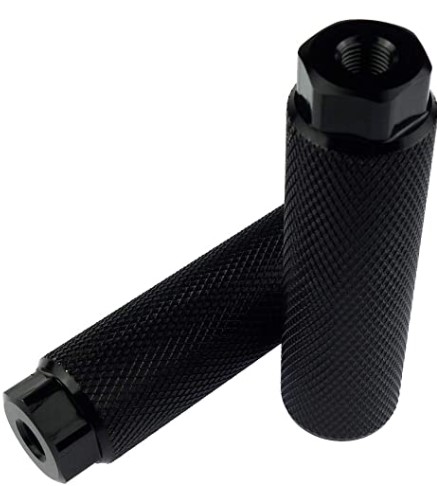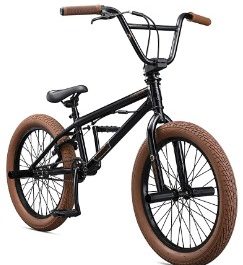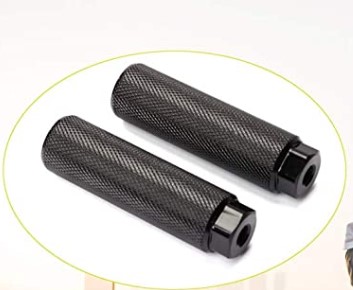We know the difference pegs make in BMX bikes when performing stunts and carrying luggage or people short distances. So, you may think about their installation on your mountain bike, but can you put pegs on a mountain bike?
Well, the short answer is YES! However, your mountain bike must have a steel build, a reinforced hub, a long bolt-on axle, and a high bottom bracket. More importantly, your mountain bike should be single-speed.
If your mountain bike lacks any of these features, it becomes challenging to put pegs on it. That means you must modify your bike, which comes with several risks like voiding your warranty and wheel damage which may be irreparable.
This guide will look at the ups and downs of putting pegs on your mountain bike. But first, let’s understand what bike pegs are.
What Are Bike Pegs?
Bike pegs are metal bars that attach to the axle of each bike wheel. These small bars help the rider perform maneuvers like grinds and stunts, carry luggage or a passenger, and allow you to jump or stand.

But Can You Put Pegs On a Mountain Bike? And If Yes, When?
Now that you understand what bike pegs are, I must reaffirm that it’s possible to put pegs on mountain bikes. However, you’ve to meet several requirements, which include the following:
1. Your Bike Build Is Steel
Steel is more robust than carbon fiber and aluminum counterparts. That’s why stunt bikes (BMX bikes) come in a steel frame.
So, if your mountain bike has a steel frame and you want to perform grinds, steel will allow you to do some maneuvers like stunts. For this reason, you can put pegs on your mountain bike.
2. Reinforced Hub
Now, if your mountain bike comes with a through axle skewer or has a quick-release skewer, you need to replace it with a long bolt-on axle one.
While at it, ensure that you replace your bike’s hub with a more reinforced option. Reinforced hubs can limit impacts and prevent them from reaching the derailleurs and disc brakes.
3. Your Bike Have Bolt-on Axles
Another feature that allows you to attach pegs on your mountain bike is a long bolt-on axle. The axel acts as the base for putting pegs on your mountain bike.
The thicker and more prolonged the axles are, the better they will hold the pegs. That will, in turn, limit impacts from destroying the wheel.
Your axle should be 14mm thick, the same as BMX axles, and great for attachment pegs.
4. Your Bottom Bracket Is High
If your mountain bike’s bottom bracket is high, it will offer excellent grinding and minimal crank interference, which translates to good performance.
However, if your bike has a lowly placed bottom bracket, you can take your bike to your local bike repair shop to have it adjusted. The good news is that the adjustment does not void your bike warranty.
5. Your Mountain Bike Is Single-Speed
As we will look at later, putting pegs on your mountain bike comes with several risks. One primary risk is the pegs getting into the spokes, damaging the whole wheel, which you won’t like.
But if you own a single-speed bike, you can comfortably put pegs as the bike lacks derailleurs. However, as we know, mountain bikes come with gears, and if this is your case, you can ditch the gear and switch your bike to a single speed, but you need to take caution while doing it.
Why Putting Pegs On Your Mountain Bike Is Not a Good Idea
Putting pegs on your mountain bike comes with several risks. Below are the most common:
a) Your Bike Frame May Bend
The frame is the soul of your bike. Once it’s ruined, it will be expensive to replace. So, for pegs installation, your bike frame should be strong.
The difference between a mountain bike frame and that of a BMX bike is that mountain bike frames are slimmer and longer than BMX bikes that are shorter and thicker, which is why BMX is excellent for stunts.
That said, if your mountain bike frame is carbon fiber or aluminum, as is mostly the case, putting pegs on these materials will put too much stress on the fork and frame, and the result will be cracked, broken, or the frame will bend.
b) Snapping of The Wheel
Another risk of putting pegs on your mountain bike is wheel snapping. Remember, pegs fit onto your wheel axle. In mountain bikes, the derailleur and disc brakes are near the axle.
So, when you hit a ledge, the two components become susceptible to damage that may be irreparable. If this happens severely, the damage won’t stop there.
The impact can get into the derailleur, pushing further to the spokes. In turn, the spokes connect to the rim; if the spokes are hit hard, it will snap the rim, which means the whole wheel will be damaged. You can see why it’s not wise to put pegs on your mountain bike.
c) Loose Installation
Even though you may follow the process of installing pegs to your mountain bike to the latter, the risk of the pegs becoming loose is inevitable. That is a certainty because MTB mechanisms are not compatible with peg installation.
The reason to back my argument is that mountain bikes usually come either through axle skewers or quick-release skewers, which often have a shorter length. That means that they can’t provide a good base for peg support.
However, you need to install bolt-on axles which will cost you money. Still, despite ditching to bolt-on axles, there is no guarantee that the pegs won’t snap. In most cases, the pegs become loose in one way or another.
d) Flat Tires
I carried my ten-year-old on my mountain bike that I recently installed pegs on to try out the fun of my kid hopping on my mountain bike, and my tires went flat.
Why am I telling you this? Well, mountain bikes ride on low pressure (PSI). That means that your bike can only bear a specific impact and weight.
So, if you are using pegs and want to carry luggage or a passenger, it will surpass the total bike carry weight, and in turn, your bike will suffer flat tires.
e) Warranty Void
I advise you to consult your bike warranty terms and conditions before you can go ahead with installing MTB pegs. Most mountain bike manufacturers do not allow warranty repairs in cases where modifications lead to damage.
Even worse, pegs are on top of the disapproval list of many bike manufacturers. So, if you want to go ahead with installing pegs on your expensive mountain bike, you void the luxury of your bike warranty repairs.

How to Put Stunt Pegs On a Mountain Bike?
Now that we have looked at circumstances that allow you to put pegs on your mountain bike, and why not, let’s look at the process if you feel like going ahead and putting pegs.
But first, you’ll need the right pegs for mountain bikes (View on Amazon).
- Step 1 – Remove the washer and nut from the axle.
- Step 2 – Given that you already installed the bolt-on axle, mount the peg on it.
- Step 3 – Tighten the peg using a deep socket.
- Step 4 – Repeat the same process to the other wheel
- Step 5 – Before trying it out, check if the brakes align well with the wheel. If they are correctly aligned, congratulations! You did a good job!
People Also Ask
1. Can You Put Pegs On Any Bike?
The short answer is NO! Bike pegs are primarily associated with stunt bikes (BMX type). That is because these bikes can bear modifications.
The other bike category you can put pegs on is the road bikes (high-end options). The reason is that they come with an already installed bolt-on axle and are the last candidate for pegs.
2. Can You Stand On Bike Pegs?
Yes, you can stand on bike pegs as long as you pedal and the bike keeps moving. However, if the bicycle slows down or stops, you will likely be uncomfortable, and the chances of losing balance and falling are pretty high. So, I advise you to wear protective gear (View on Amazon) to avoid severe injury.
3. Can You Put Pegs On a C100?
C100 is a sturdy mountain bike that comes with a 19-inch aluminum frame. Although the frame is not comparable to steel in matters of strength, its 19-inch thickness makes it durable and a good candidate for peg installation.
In Conclusion, Can You Put Pegs On a Mountain Bike?
As seen, you can put pegs on a mountain bike if its frame is steel, has a reinforced hub, bolt-on axle, a high bottom bracket, or is a single speed.
However, consider the risks like a cracked, broken, bent frame, snapping wheels, loose installation, flat tires, and warranty void.

